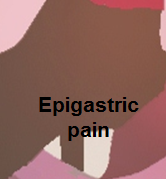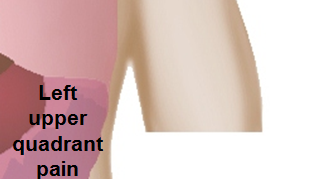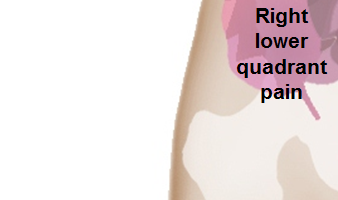Acute abdominal pain resident survival guide
Editor-In-Chief: C. Michael Gibson, M.S., M.D. [1]; Associate Editor(s)-in-Chief: Rim Halaby, M.D. [2], Amr Marawan, M.D. [3]
Definitions
| Terms | Definitions |
|---|---|
| Acute abdominal pain | Severe, persistent abdominal pain of sudden onset that is likely to require surgical intervention to treat its cause. Duration of less than several days. |
| Acute abdomen | It is defined as a sudden, abrupt onset of severe localized or generalized abdominal pain with abdominal rigidity.[1] It is less than 24 hours in duration and requires urgent evaluation and diagnosis because it may indicate a need for immediate surgical intervention.(also known as surgical abdomen)[2] |
| Subacute abdominal pain | It's a type of abdominal pain that has a duration of more than several days but less than six months. |
| Chronic abdominal pain | It has a duration of more than six months, either constantly or intermittently.[3] |
Causes
Life Threatening Causes
Life-threatening causes include conditions which may result in death or permanent disability within 24 hours if left untreated.
- Abdominal aortic aneurysm
- Acute bowel obstruction
- DKA
- Ectopic pregnancy
- Mesenteric ischemia
- Myocardial infarction
- Perforated viscus (including peptic ulcer, bowel, esophagus, or appendix)
- Placental abruption
- Splenic rupture (It is usually secondary to trauma, EBV or leukemia)
- Volvulus
Common Causes
- Acute pancreatitis
- Adnexal pathology (cyst or tumor that caused torsion, bleeding or rupture)
- Appendicitis
- Biliary disease (Acute cholecystitis)
- Bladder distension
- Chronic heroin or morphine use
- Crohn's disease
- Diverticulitis
- Dyspepsia
- Endometriosis
- Endometritis
- Hemophilia
- Hiatus hernia
- High dose steroids
- HIV infection (affecting the GI and hepatobiliary systems)
- Kidney stones
- Mesenteric infarction
- Pelvic inflammatory disease
- Peritonitis
- Sickle cell disease (as a part of vasoocclusive crisis)
- Splenic abscess
- Splenic infarction
- Ulcerative colitis
Common extraabdominal diseases
- Alcoholic ketoacidosis
- Diabetic ketoacidosis
- Herpes zoster
- Pneumonia (involving the lower lobes)
- Pulmonary embolus
Management
 |
 |

|
 |
 |

|
 |
 |

|
Do's
- Consider abdominal aortic aneurysm, mesenteric ischemia and malignancy in patients above 50 years as it is much less likely for younger patients.
- Perform pelvic and testicular examination in patients with low abdominal pain.
- Re-examine patients at high risk who were initially diagnosed with pain of unclear etiology.
- Taking careful history, characterizing the pain precisely and thorough physical examination is crucial for creating narrow differential diagnosis.
- Correlate the CD4 count in HIV positive patients with the most commonly occurring pathology.
- Order a pregnancy test before proceeding with a CT scan in females in the child bearing age.
- Order an ultrasound or magnetic resonance among pregnant females to avoid exposure to radiation. In case the previous tests were inconclusive and appendicitis is suspected, the next step in the management includes proceeding with either laparoscopy or limited CT scan.
- Suspect abdominal aortic aneurysm in old patients presenting with abdominal pain with history of tobacco use.[4]
- Suspect acute mesenteric ischemia and acute pancreatitis in patients presenting with poorly localized pain out of proportion to physical findings.[4]
- Recommend initial imaging studies based on the location of abdominal pain:
- Ultrasonography is recommended when a patient presents with right upper quadrant pain.[5]
- Computed tomography (CT) with intravenous contrast media is recommended for evaluating adults with acute right lower quadrant pain.[5]
- CT with oral and intravenous contrast media is recommended for patients with left lower quadrant pain.[5]
- Order ECG for old patients with upper abdominal pain with high cardiac risk factors.
- Administer narcotic analgesia for patients who present to the ED with moderate or severe abdominal pain.[6]
Don'ts
- Fail to evaluate elder patients in the presence of overt clinical signs.
- Over rely on laboratory tests, they are only used as adjuncts.
- Do not delay the initial intervention.
- Do not order blood cultures routinely in all patients
- Don’t delay resuscitation or surgical consultation for ill patient while waiting for imaging.
- Don’t restrict the differential diagnosis of abdominal pain based on the location; for example, right-sided structures may refer pain to the left abdomen.[4]
References
- ↑ "ICD-10 Version:2010".
- ↑ Venes, Donald (2013). Taber's Cyclopedic Medical Dictionary (Thumb-indexed Version) (Taber's Cyclopedic Medical Dictionary (Thumb Index Version)). Philadelphia, PA: F.A. Davis Company. ISBN 0-8036-2977-X.
- ↑ Lawrence S. Cohen MD; Mark W. Green MD (2010). Sleisenger and Fordtran's Gastrointestinal and Liver Disease- 2 Volume Set: Pathophysiology, Diagnosis, Management, Expert Consult Premium Edition - Enhanced ... & Liver Disease (Sleisinger/Fordtran)). Philadelphia: Saunders. ISBN 1-4160-6189-4.
- ↑ 4.0 4.1 4.2 "Diagnosis and management of 528 abdom... [Br Med J (Clin Res Ed). 1981] - PubMed - NCBI".
- ↑ 5.0 5.1 5.2 "http://www.acr.org/". External link in
|title=(help) - ↑ "http://www.ebmedicine.net/content.php?action=showPage&pid=94&cat_id=16". External link in
|title=(help)